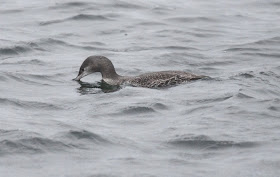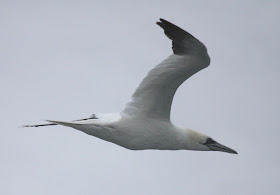Rhode Island- Thursday, December 15, 2011- After I saw the Black-headed Gull on Monday on the Gale Francis, I wanted to go back and see if it was still in the Harbor and hopefully photograph it again. On Monday, the Bonaparte’s Gulls with the Black-headed were feeding along the docks on the Galilee side near the narrows by the Fisherman’s Co-op. I decided to start looking for the Gull in Galilee, and with all the local Gulls hanging around the piers, there might be an Iceland
From the corner docks near the Francis Fleet, I started looking around the harbor for the flock of feeding Bonaparte’s Gulls, with hopefully the Black-headed Gull. I covered just about every square inch of the harbor through my binoculars as I could. Not finding the Gulls, I decided to drive down to the narrows just as the forecasted rain began. I was hoping to get as much time in as I could before the rain started, but too late, the rain was here. Although it was only a light rain, it was enough to get my camera and binoculars wet. When I drove into the Salty Brine parking lot, the fury of the wind was obvious, as sand from the beach was blowing right down the road leading the parking lot. A quick look from the lot didn’t reveal much other than a few common Gulls, a pair of Red-throated Loons, and a single drake Common Eider sleeping on a rock on the other shore at the narrows.
Since I hadn’t seen the flock of Bonaparte’s Gulls that I was looking for, I decided to drive over to Camp Cronin Harbor of Refuge
After fifteen minutes of sea watching, I drove back over to the Frances Fleet dock. I looked across the harbor, and saw a flock of feeding Red-breasted Mergansers. Just over the mergansers heads was a small flock of Bonaparte’s Gulls. The Gulls were flying low over the water in their typical twisting effortless flight making occasional dives into the water; classic feeding behavior for this elegant small Gull. The Mergansers and Gulls slowly advanced down the Matunuck side of the harbor passing Snug Harbor
There were a handful of Gulls in this flock, and I searched through all of them for their slightly larger cousin, but couldn’t locate it. The birds slowly moved in my direction passing beyond the inlet to Succotash Pond. A second group of Bonaparte’s Gulls appeared coming from the north in Point Judith Pond, and joined the other Gulls and the Mergansers. As the two flocks of nearly thirty Bonaparte’s Gulls became one, I scoured all of them looking for the Black-headed Gull. I didn’t see the Gull, and hoped to myself that this bird didn’t leave. As I continued looking through all the Gulls, a third small group of five Gulls (again coming from the north in Point Judith Pond) joined the feeding flock of Mergansers and Bonaparte’s Gulls. As the five birds approached, the tell-tale Black and White wing flash of one of the Gulls was obvious; the Black-headed Gull was still here. The birds came much closer to the Galilee docks, but still flying along the shores of the Succotash Marsh Management Area. I was rewarded with really good views of the gull (although distant) mixing with the Bonaparte’s Gulls and Mergansers for ten to fifteen minutes.
But the very strong incoming tide accelerated by the heavy southerly winds, pushed the large school of baitfish back up into the Pond, and the Gulls followed. Within a few minutes the Gulls and Mergansers were disappearing from sight as they rounded High Point Great Island and relocated the Gulls; they were quietly resting far out on the Pond in the cove between Jonathan and Ram Islands East Matunuck and sit on the town dock. Along the route, there was a single Pied –billed Grebe in the creek near Capt. Jacks. I sat on the dock for over an hour, but the Gulls never returned, and neither did the change in tide. There were a few Red-throated Loons that swam near the dock, but not much else.
On my way home I drove along the coast and made a few quick stops on my way to the Charlestown Breachway my second planned stop. When I got to the Breachway parking lot, I was the only one there. The wind was still howling and I knew that giant built up waves crashing onto the beach. The roar of the sea was deafening. I could only imagine its fury from the visual of the bent over dune grass on the edge of the parking area. Looking ahead into the canal, the current of the wind driven incoming tide rivaled the currents of the wildest western rivers. Walking around the corner of the dunes, the drama of the sea was quickly unveiled as a single Gannet passed by within yards of the jetty disappearing into the trough of a large wave as the cascading spray painted the tip of the sea wall.
I have had a life long fascination with the sea; both for its birds and its images projected on a painter’s canvas such as the masterpieces of Winslow Homer. I have spent most of my life both on and/or near the sea, and have fashioned a professional career from the birds that are associated with it. When looking out over an ocean, it is the waves that captivate me, their motions expressing the passion of the sea.
I felt the push of the wind as I walked down the jetty to nearly the tip. Waves were breaking high and fast all around me, and the sea painted a thousand paintings. Common Loons and Scoters were scattered on the sea. As if celebrating the sea, a steady cortege of Gannets passed by sometimes within yards, and other times right over my head.
Here are a few images highlighting the birds. They are showcased on a canvas of the sea and positioned among the naturally sculpted movement of the waves.
Common Loons:
Common Loons:
with a crab.......
Red-throated Loons:
Sea Ducks:
Common Scoters-
Red-breasted Mergansers-
Common Eiders-
hen Eider with a Common Scoter drake.....
hen Eider with juvenile drake (right)
third year.......
second year......
While I was reviewing the images, I discovered this Razorbill......
......and unfortunately, this adult Gannet had expired!
This is me getting soaked!!
This first year Gannet came from behind me and then flew up the jetty and passed over the parking lot. It emerged over the dunes and crossed over the beach and then over the surf.

A single Harbor Seal-
The Charlestown Breachway:
Location of the Black-headed Gull:
This report is a follow-up to Monday's Pelagic trip "the Cod Grounds and the Little Auk". To review this report, just turn the page by clicking on "Older Posts" below right.
Keith Mueller Killingworth, CT






































































































































































